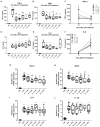Anti-Inflammatory and Antibacterial Effects and Mode of Action of Greek Arbutus, Chestnut, and Fir Honey in Mouse Models of Inflammation and Sepsis
- PMID: 36557628
- PMCID: PMC9784341
- DOI: 10.3390/microorganisms10122374
Anti-Inflammatory and Antibacterial Effects and Mode of Action of Greek Arbutus, Chestnut, and Fir Honey in Mouse Models of Inflammation and Sepsis
Abstract
Background: Honey has been shown to possess anti-inflammatory and bactericidal properties that may be useful for the prevention and treatment of infections as well as of acute and chronic inflammatory diseases. The antimicrobial potency of honey could be attributed to its physicochemical characteristics combined with the presence of certain compounds, such as hydrogen peroxide and polyphenols. Honey's bacteriostatic or bactericidal capacity varies depending on its composition and the bacterial type of each infection. Nevertheless, not all honey samples possess anti-inflammatory or antibacterial properties and their mechanism of action has not been clearly elucidated. Objectives: We therefore investigated the anti-inflammatory properties of three different honey samples that derived from different geographical areas of Greece and different botanical origins, namely, arbutus, chestnut, and fir; they were compared to manuka honey, previously known for its anti-inflammatory and antibacterial activity. Materials and Methods: To test the anti-inflammatory activity of the different samples, we utilized the in vivo model of LPS-driven inflammation, which induces septic shock without the presence of pathogens. To evaluate the antibacterial action of the same honey preparations, we utilized the cecal-slurry-induced peritonitis model in mice. Since acute inflammation and sepsis reduce the biotransformation capacity of the liver, the expression of key enzymes in the process was also measured. Results: The administration of all Greek honey samples to LPS-stimulated mice revealed a potent anti-inflammatory activity by suppressing the TNFα serum levels and the expression of TNFα and iNOS in the liver at levels comparable to those of the manuka honey, but they had no effect on IL-6 or IL-1β. It was shown that the LPS-induced suppression of CYP1A1 in the liver was reversed by Epirus and Crete fir honey, while, correspondingly, the suppression of CYP2B10 in the liver was reversed by Evros chestnut and Epirus fir honey. The effect of the same honey samples in polymicrobial peritonitis in mice was also evaluated. Even though no effect was observed on the disease severity or peritoneal bacterial load, the bacterial load in the liver was reduced in mice treated with Evros chestnut, Epiros fir, and Crete fir, while the bacterial load in the lungs was reduced in Epirus arbutus, Crete fir, and manuka honey-treated mice. Conclusion: Our findings suggest that these specific Greek honey samples possess distinct anti-inflammatory and antibacterial properties, as evidenced by the reduced production of pro-inflammatory mediators and the impaired translocation of bacteria to tissues in septic mice. Their mode of action was comparable or more potent to those of manuka honey.
Keywords: LPS; Manuka; TNF-a; antimicrobial; bactericidal; cecal slurry-induced peritonitis; honey; iNOS; inflammation; mice; natural compounds; sepsis.
Conflict of interest statement
The authors declare no conflict of interest.
Figures





Similar articles
-
Antimicrobial Evaluation of Various Honey Types against Carbapenemase-Producing Gram-Negative Clinical Isolates.Antibiotics (Basel). 2022 Mar 21;11(3):422. doi: 10.3390/antibiotics11030422. Antibiotics (Basel). 2022. PMID: 35326885 Free PMC article.
-
Microbial Community Structure among Honey Samples of Different Pollen Origin.Antibiotics (Basel). 2023 Jan 6;12(1):101. doi: 10.3390/antibiotics12010101. Antibiotics (Basel). 2023. PMID: 36671302 Free PMC article.
-
Manuka honey modulates the release profile of a dHL-60 neutrophil model under anti-inflammatory stimulation.J Tissue Viability. 2020 May;29(2):91-99. doi: 10.1016/j.jtv.2020.03.005. Epub 2020 Mar 26. J Tissue Viability. 2020. PMID: 32249090 Free PMC article.
-
Anti-bacterial, anti-biofilm and anti-quorum sensing activities of honey: A review.J Ethnopharmacol. 2023 Dec 5;317:116830. doi: 10.1016/j.jep.2023.116830. Epub 2023 Jul 1. J Ethnopharmacol. 2023. PMID: 37400003 Review.
-
The effects of honey on pro- and anti-inflammatory cytokines: A narrative review.Phytother Res. 2021 Jul;35(7):3690-3701. doi: 10.1002/ptr.7066. Epub 2021 Mar 9. Phytother Res. 2021. PMID: 33751689 Review.
Cited by
-
Integrated Assessment of Antibacterial Activity, Polyphenol Composition, Molecular Docking, and ADME Properties of Romanian Oak and Fir Honeydew Honeys.Antibiotics (Basel). 2025 Jun 8;14(6):592. doi: 10.3390/antibiotics14060592. Antibiotics (Basel). 2025. PMID: 40558182 Free PMC article.
-
Honey microbiota, methods for determining the microbiological composition and the antimicrobial effect of honey - A review.Food Chem X. 2024 Jun 4;23:101524. doi: 10.1016/j.fochx.2024.101524. eCollection 2024 Oct 30. Food Chem X. 2024. PMID: 38947342 Free PMC article. Review.
-
Anti-Inflammatory and Wound Healing Properties of Different Honey Varieties from Romania and Correlations to Their Composition.Life (Basel). 2024 Sep 20;14(9):1187. doi: 10.3390/life14091187. Life (Basel). 2024. PMID: 39337969 Free PMC article.
-
Honey as a Natural Nutraceutical: Its Combinational Therapeutic Strategies Applicable to Blood Infections-Septicemia, HIV, SARS-CoV-2, Malaria.Pharmaceuticals (Basel). 2023 Aug 14;16(8):1154. doi: 10.3390/ph16081154. Pharmaceuticals (Basel). 2023. PMID: 37631069 Free PMC article. Review.
-
Review on role of honey in disease prevention and treatment through modulation of biological activities.Open Life Sci. 2025 Mar 7;20(1):20251069. doi: 10.1515/biol-2025-1069. eCollection 2025. Open Life Sci. 2025. PMID: 40059876 Free PMC article. Review.
References
-
- Rudd K.E., Johnson S.C., Agesa K.M., Shackelford K.A., Tsoi D., Kievlan D.R., Colombara D.V., Ikuta K.S., Kissoon N., Finfer S., et al. Global, regional, and national sepsis incidence and mortality, 1990-2017: Analysis for the Global Burden of Disease Study. Lancet. 2020;395:200–211. doi: 10.1016/S0140-6736(19)32989-7. - DOI - PMC - PubMed
-
- El-Seedi H.R., Eid N., Abd El-Wahed A.A., Rateb M.E., Afifi H.S., Algethami A.F., Zhao C., Al Naggar Y., Alsharif S.M., Tahir H.E., et al. Honey Bee Products: Preclinical and Clinical Studies of Their Anti-inflammatory and Immunomodulatory Properties. Front. Nutr. 2022;8:761267. doi: 10.3389/fnut.2021.761267. - DOI - PMC - PubMed
-
- Combarros-Fuertes P., Estevinho L.M., Dias L.G., Castro J.M., Tomás-Barberán F.A., Tornadijo M.E., Fresno-Baro J.M. Bioactive Components and Antioxidant and Antibacterial Activities of Different Varieties of Honey: A Screening Prior to Clinical Application. J. Agric. Food Chem. 2019;67:688–698. doi: 10.1021/acs.jafc.8b05436. - DOI - PubMed
-
- El-Kazafy A.T., Saad A.-K., Reda T. Comparison of Pollen Spectra and Amount of Mineral Content in Honey Produced by Apis florea F. and Apis mellifera L. J. Kans. Entomol. Soc. 2018;91:51–57. doi: 10.2317/0022-8567-91.1.51. - DOI
LinkOut - more resources
Full Text Sources

